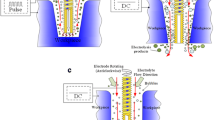Abstract
Wire electrochemical machining is a highly flexible machining method based on the electrochemical dissolution of a workpiece anode, which corrodes. Material is removed locally from the workpiece as the tool is moved through two dimensions. In electrochemical cutting using a tube electrode, a metal tube with an array of holes on the sidewall replaces the conventional wire as the tool cathode. The electrolyte enters through the top of the tube electrode, is ejected though the array of holes, and directly sprays onto the machining surface of the workpiece. In this paper, the flow of the electrolyte in the machining gap was simulated for tube electrodes with different holes spacing and inclination angles. Experiments verified that the refreshment of the electrolyte and the removal of electrolysis products were fast and the machining efficiency was high when the holes spacing was 1 mm and inclination angle was −45°. Adding supplementary electrolyte into the slit improves the consistency of the slit width. Finally, using the optimized structural parameters, arrays of columns were fabricated from 10-mm-thick stainless steel 304 at a feed rate of 7 μm/s.



















Similar content being viewed by others
References
Rajurkar KP, Zhu D, McGeough JA, Kozak J, De SA (1999) New developments in electro-chemical machining. CIRP Ann - Manuf Technol 48:567–579
Niu S, Qu NS, Fu SX, Fang XL, Li HS (2017) Investigation of inner-jet electrochemical milling of nickel-based alloy GH4169 / Inconel 718. Int J Adv Manuf Technol 93:2123–2132
Sharma V, Srivastava I, Jain V, Ramkumar J (2019) Modelling of wire electrochemical micromachining (wire-ECMM) process for anode shape prediction using finite element method. Electrochim Acta 312:329–341
Saxena KK, Qian J, Reynaerts D (2018) A review on process capabilities of electrochemical micromachining and its hybrid variants. Int J Mach Tools Manuf 127:28–56
Debnath S, Kundu J, Bhattacharyya B (2017) Influence of wire electrochemical machining parameters during fabrication of micro features. Int J Precis Technol 7:103–118
Debnath S, Doloi B, Bhattacharyya B (2019) Review—wire electrochemical machining process: overview and recent advances. J Electrochem Soc 166:E293–E309
Sharma S, Jain V, Shekhar R (2002) Electrochemical Drilling of Inconel Superalloy with acidified sodium chloride electrolyte. Int J Adv Manuf Technol 19:492–500
Jiang K, Wu XY, Lei JG, Wu W, Li W, Diao DF (2018) Vibration-assisted wire electrochemical micromachining with a suspension of B4C particles in the electrolyte. Int J Adv Manuf Technol 97:3565–3574
Xu K, Zeng YB, Li P, Zhu D (2015) Study of surface roughness in wire electrochemical micro machining. J Mater Process Technol 222:103–109
Fang XL, Zou XH, Zhang PF, Zeng YB, Qu NS (2016) Improving machining accuracy in wire electrochemical micromachining using a rotary helical electrode. Int J Adv Manuf Technol 84:929–939
He HD, Qu NS, Zeng YB, Fang XL, Yao YY (2016) Machining accuracy in pulsed wire electrochemical machining of γ-TiAl alloy. Int J Adv Manuf Technol 86:2353–2359
Yang T, Zeng YB, Hang YS (2019) Workpiece reciprocating movement aided wire electrochemical machining using a tube electrode with an array of holes. J Mater Process Technol 271:634–644
Xu K, Zeng YB, Li P, Fang XL, Zhu D (2016) Effect of wire cathode surface hydrophilic when using a travelling wire in wire electrochemical micro machining. J Mater Process Technol 235:68–74
He HD, Qu NS, Zeng YB, Tong PZ (2017) Improvement of hydrogen bubbles detaching from the tool surface in microwire electrochemical machining by applying surface microstructures. J Electrochem Soc 164:E248–E259
Zou XH, Fang XL, Chen M, Zhu D (2018) Investigation on mass transfer and dissolution localization of wire electrochemical machining using vibratory ribbed wire tools. Precis Eng 51:597–603
Meng LC, Zeng YB, Zhu D (2018) Helical carbon nanotube Fiber tool cathode for wire electrochemical micromachining. J Electrochem Soc 165:E665–E673
Fang XL, Zhang PF, Zeng YB, Qu NS, Zhu D (2016) Enhancement of performance of wire electrochemical micromachining using a rotary helical electrode. J Mater Process Technol 227:129–137
Zou XH, Fang XL, Zeng YB, Zhu D (2017) A high efficiency approach for wire electrochemical micromachining using cutting edge tools. Int J Adv Manuf Technol 91:3943–3952
Klocke F, Herrig T, Zeis M, Klink A (2018) Experimental investigations of cutting rates and surface integrity in wire electrochemical machining with rotating electrode. Procedia CIRP 68:725–730
Klocke F, Herrig T (2018) Klink a (2018) evaluation of wire electrochemical machining with rotating electrode for the manufacture of fir tree slots. Proc ASME Turbo Expo 6:1–6
Zeng YB, Yu Q, Fang XL, Xu K, Li HS, Qu NS (2015) Wire electrochemical machining with monodirectional traveling wire. Int J Adv Manuf Technol 78:1251–1257
Qu NS, Fang XL, Zhang YD, Zhu D (2013) Enhancement of surface roughness in electrochemical machining of Ti6Al4V by pulsating electrolyte. Int J Adv Manuf Technol 69:2703–2709
Funding
This project was supported by the National Natural Science Foundation of China (51975291), the Natural Science Foundation of Jiangsu Province (BK20192007), and the Postgraduate Research & Practice Innovation Program of Jiangsu Province (KYCX19_0167).
Author information
Authors and Affiliations
Corresponding author
Additional information
Publisher’s note
Springer Nature remains neutral with regard to jurisdictional claims in published maps and institutional affiliations.
Rights and permissions
About this article
Cite this article
Yang, T., Zeng, Y., Sang, Y. et al. Effect of structural parameters of array of holes in the tube electrode for electrochemical cutting. Int J Adv Manuf Technol 107, 205–216 (2020). https://doi.org/10.1007/s00170-020-05089-0
Received:
Accepted:
Published:
Issue Date:
DOI: https://doi.org/10.1007/s00170-020-05089-0



